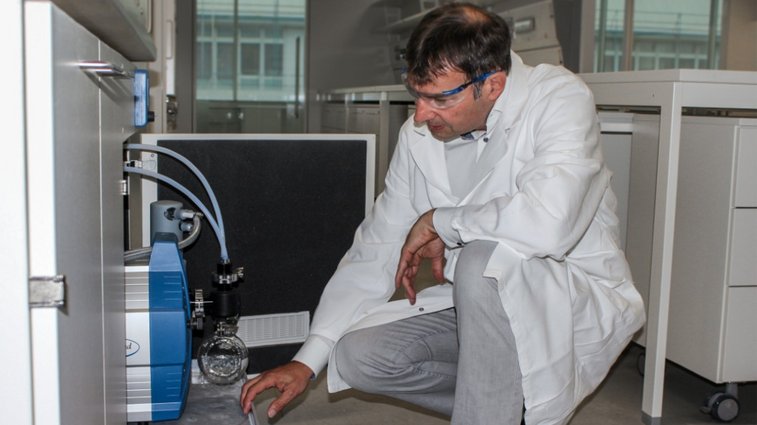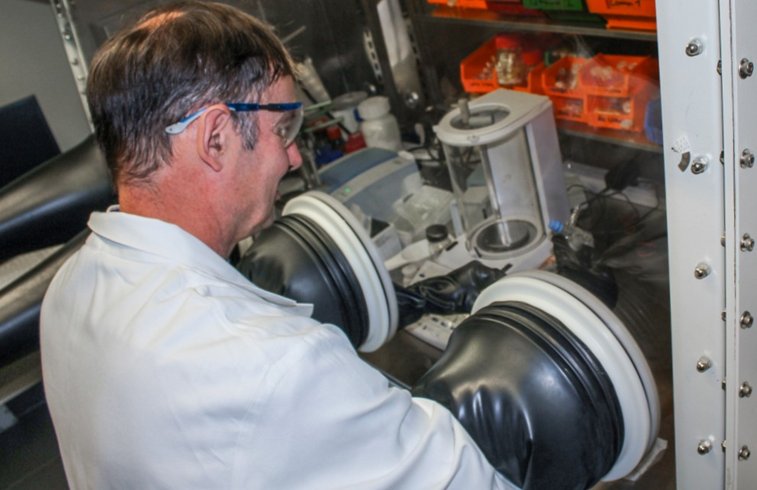
Numerous requirements for laboratory use – also for vacuum supply
© Universität Würzburg
The most important step at the beginning of any laboratory planning process is the needs assessment. This is when users and planners meet together in order to jointly determine the requirements for the new laboratory. One challenge is that all of these requirements are sometimes not fully discussed. This is often because users take their daily processes from the existing laboratory for granted, however, planners are not necessarily familiar with these daily routines. One solution for more effective cooperation is to determine the requirements in detail at the very beginning of the planning process – by conducting risk assessments. Dr. Stephan Wagner from the Institute of Inorganic Chemistry at the University of Würzburg discusses in an interview about this method, which he has been able to apply successfully in a number of projects.
Which projects do you supervise at the University of Würzburg?
Dr. Stephan Wagner: At the Faculty of Chemistry and Pharmacy of the Julius Maximilian University of Würzburg, we have implemented several new buildings in recent years. For some of these projects, I myself have acted as the faculty's construction supervisor. For example, a laboratory building for undergraduate courses in chemistry, physics and biology was built in 2011. Furthermore, in 2018, a large new institute building for the Faculty of Inorganic Chemistry was created with a laboratory space of 3,000 m2 alone, as well as one of the largest NMR* laboratories in northern Bavaria. Now in 2021, we are in the process of commissioning a research building for the Institute for Sustainable Chemistry and Catalysis with Boron.
* NMR spectroscopy (Nuclear Magnetic Resonance) is based on the study of the electronic environment of individual atoms and their interactions with neighboring atoms. This method is used both to elucidate the structure of small to large, complex molecules and to study interactions between molecules.
Who is involved in a laboratory planning?
Dr. Stephan Wagner: A new building requires the complex interaction between many people. In principle, the university is the building owner. However, the State Building Construction Department is responsible for its realization; it is responsible for the entire project management and commissions the corresponding planning offices. Therefore, in the planning phase, a diverse range of participants are involved – from the university, the building construction department and the planning office.
Is the planning the same for all laboratory types?
Dr. Stephan Wagner: At the University in Würzburg, we have undergraduate labs, institute labs and research labs as standard and for all of them, the requirements of the different users are the focus of the planning. In some labs, we have over 100 employees – you can imagine the effort that goes into determining their requirements.
In an undergraduate laboratory, the users are students who apply working techniques that will not change over a very long period of time. In an institute laboratory, on the other hand, the users are scientists and also advanced students with a comparatively smaller number of working techniques. Of course, changes in requirements can arise, for example, in the case of new professors being appointed during the planning or construction phase. That is why the lab spaces should be planned somewhat more flexibly. In a pure research laboratory, the users are exclusively scientists with a rather limited number of working techniques, whose requirements, however, can be quite high.
Comparing these three types of laboratories, one comes to the conclusion that the user requirements are quite different and that the determination of them can also be somewhat difficult.
What challenges do you know from laboratory planning?
Dr. Stephan Wagner: In principle, it must be said that both users and planners start from different premises. What does a planning office need? A complete list of all requirements. What do the users need? A laboratory in which they can carry out chemistry without restrictions.
However, the question "What are your requirements for a new laboratory?" sometimes leads to answers such as "I need the largest possible draining rack above the sink." These very specific suggestions are not very helpful at the beginning of the planning process. Rather, it is more a matter of basic requirements for the functioning of a laboratory. But the user only knows his current work situation and cannot really imagine a new laboratory.
Another challenge is that users take for granted that the lab designer must already know certain requirements. My very favorite statement I've heard, "How do I know you don't know what I want?" I think there is a relatively big misunderstanding here. The lab planner is generally not a chemist, nor does he or she have an intimate knowledge of the user's chemistry. So it is sometimes difficult to fully articulate all the requirements as part of the redesign of a laboratory. This can often lead to incorrect planning.
What are some examples of misplanning?
Dr. Stephan Wagner: For example, from users typically come statements such as "I need an efficient vacuum network in the undergraduate lab. There, I need two connections in each fume hood for vacuum diaphragm pumps." Now this is not a particular challenge at first, but rather quite standard. What the user doesn't say, however, is that one port is to be used only for filtrations and the other port for distillations. And both are to be used simultaneously, preferably by 10 different students at the same time. They realize that if we don't plan two different vacuum networks here, the system will collapse completely as soon as the lab is put into operation. Fortunately, something like this can still be solved relatively easily afterwards.
The requirements for a BET analyzer to determine the pore size of metal-organic frameworks (MOFs), for example, are somewhat more difficult. It happens that the laboratory planner receives documentation from the analyzer, but is not told that the experiments are sometimes performed using nitric oxide and carbon monoxide gas. This requires fairly specific safety measures. However, if these are missing, we are actually talking about a classic mis-planning and the lab is completely useless. You can run a BET analyzer, but unfortunately not with the gases you want to work with.
What solution do you recommend for complete needs assessment?
Dr. Stephan Wagner: I think you first have to ask the right questions. You must not ask about the requirements, but about the experiments or, even better, about the activities. What hazards are caused by these activities? What requirements must be met in the laboratory so that the activities can be carried out safely? And this is actually nothing other than a classic risk assessment. We have had very good experience with carrying this out at the very beginning of the planning process.
How does a risk assessment proceed?
Dr. Stephan Wagner: We have standardized our systematic risk assessments using a form. In this form, we first ask what activities are actually being performed. Then we note down all the associated workplace-specific risks. And once we have recorded these, we also know relatively precisely the technical requirements that must be placed on such a laboratory.
Do you have an example of successful planning?

Risk assessments as a tool to determine requirements for glove boxes
© Universität Würzburg
Dr. Stephan Wagner: I remember the following requirement: "We need a room to run a glove box in." According to the users, all that was needed was
- electricity connection,
- water connection and
- connection for high-purity argon or nitrogen.
During the systematic risk assessment, however, it then became clear that the copper catalyst must be regenerated from time to time. To do this, you need a forming gas*. And depending on which forming gas you use, it is quite possible that an explosive gas mixture will be created. The activated carbon filter* also needs to be replaced occasionally. This filter is contaminated with pollutants and fine dust particles are released.
These activities are first overlooked by the classic user. If the result of the risk assessment is then translated into a list of requirements, you will see that the list has become significantly longer:
- Appropriate exhaust air for the vacuum pumps and for the process gas
- Gas extraction station for the forming gas
- Fume hood nearby for the activated carbon filter to be replaced
- Connection to the uninterruptible power supply, because almost all glove boxes are now supplied with an internal refrigerator.
- 8-fold air exchange, so that no inert gas atmosphere accumulates when a glove bursts.
- And much more
I think then it becomes fairly clear what a good tool a risk assessment is as part of the planning process for a new lab.
* Forming gas is a collective name for slightly reducing gas mixtures of nitrogen or argon and hydrogen. Forming gas is used as a protective gas in the hot processing of metals.
* Activated carbon filters are used for the treatment and purification of both gases and liquids.
What are the specific requirements for the vacuum supply?
Dr. Stephan Wagner: The requirements depend on many factors – such as required vacuum levels, type and quantity of solvents, method of vacuum control or number of tapping points. At the University of Würzburg, we have implemented both single-user “stand-alone” vacuum and local vacuum networks with VACUUBRAND:
In the case of single-user vacuum, each workstation is equipped with a separate vacuum pump. For example, powerful rotary vane pumps supply our Schlenk Lines or Glove Boxes with sufficiently deep vacuum. This is important to maintain the safety-relevant inert gas atmosphere.
In a local vacuum network – the so-called VACUU·LAN – each vacuum pump supplies multiple workplaces. We have various vacuum networks with chemistry diaphragm pumps for distillations, filtrations or rotary evaporation. The individual ports are protected by integrated check valves to prevent mutual interference and cross-contamination. We mainly use this solution for laboratories with many users and working techniques. Vacuum networks are necessary for us to be able to safely operate several processes simultaneously.
As you can see, there are different requirements and possibilities for setting up a vacuum supply in our laboratories. That's why it also makes sense here to use risk assessments as a tool in laboratory planning.
We would like to thank Dr. Stephan Wagner and the University of Würzburg for the interview.
